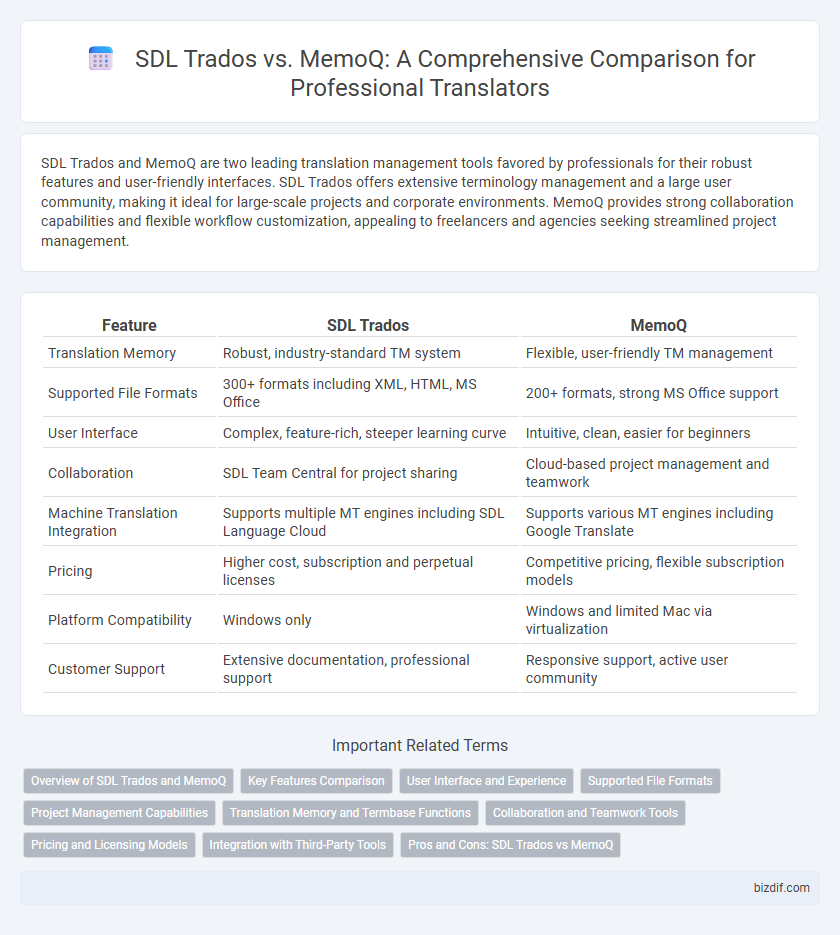SDL Trados and MemoQ are two leading translation management tools favored by professionals for their robust features and user-friendly interfaces. SDL Trados offers extensive terminology management and a large user community, making it ideal for large-scale projects and corporate environments. MemoQ provides strong collaboration capabilities and flexible workflow customization, appealing to freelancers and agencies seeking streamlined project management.
Table of Comparison
| Feature | SDL Trados | MemoQ |
|---|---|---|
| Translation Memory | Robust, industry-standard TM system | Flexible, user-friendly TM management |
| Supported File Formats | 300+ formats including XML, HTML, MS Office | 200+ formats, strong MS Office support |
| User Interface | Complex, feature-rich, steeper learning curve | Intuitive, clean, easier for beginners |
| Collaboration | SDL Team Central for project sharing | Cloud-based project management and teamwork |
| Machine Translation Integration | Supports multiple MT engines including SDL Language Cloud | Supports various MT engines including Google Translate |
| Pricing | Higher cost, subscription and perpetual licenses | Competitive pricing, flexible subscription models |
| Platform Compatibility | Windows only | Windows and limited Mac via virtualization |
| Customer Support | Extensive documentation, professional support | Responsive support, active user community |
Overview of SDL Trados and MemoQ
SDL Trados and MemoQ dominate the translation software market, each offering robust features tailored to professional linguists. SDL Trados excels with its extensive translation memory and terminology management, supporting a wide range of file formats and integrations for efficient project workflows. MemoQ stands out with its user-friendly interface, real-time collaboration tools, and flexible customization options that enhance productivity for freelance translators and large teams alike.
Key Features Comparison
SDL Trados offers a comprehensive translation memory system, advanced terminology management, and seamless integration with a wide range of file formats, enhancing productivity for large-scale projects. MemoQ stands out with its intuitive user interface, real-time collaboration tools, and robust translation QA features that minimize errors during the translation process. Both tools support machine translation integration and cloud-based project management, but SDL Trados is preferred for extensive enterprise use, while MemoQ is favored by freelancers and small teams for flexibility and ease of use.
User Interface and Experience
SDL Trados offers a robust user interface with customizable toolbars and a familiar layout for experienced translators, enhancing workflow efficiency. MemoQ features an intuitive, modern interface with drag-and-drop functionality and real-time collaboration tools that streamline project management. User experience in MemoQ is often praised for its ease of use and faster learning curve compared to SDL Trados, which can be more complex for new users.
Supported File Formats
SDL Trados supports over 70 file formats, including popular document types such as Microsoft Office files, XML, HTML, and complex file formats like InDesign and FrameMaker. MemoQ offers compatibility with a wide range of file formats as well, supporting over 60 types including Microsoft Office documents, XML, HTML, and various CAT tool exchange formats such as XLIFF and SDLXLIFF. The extensive file format support in both SDL Trados and MemoQ ensures seamless integration with diverse translation workflows and content management systems.
Project Management Capabilities
SDL Trados offers robust project management features with centralized workflow automation, resource allocation, and detailed reporting tools that streamline complex translation projects. MemoQ provides advanced project management capabilities including real-time collaboration, intuitive task management, and built-in quality assurance, which enhance productivity and ensure consistency across multilingual assignments. Both platforms support integration with CAT tools and provide comprehensive dashboards for tracking project progress and deadlines, making them essential for efficient translation project execution.
Translation Memory and Termbase Functions
SDL Trados offers a robust Translation Memory (TM) system with extensive compatibility across multiple file formats, enabling efficient reuse of previously translated content. MemoQ features an intuitive TM and Termbase management interface that supports real-time term recognition and seamless integration with machine translation engines. Both platforms provide advanced termbase functions, but MemoQ's dynamic updating capabilities and collaborative tools enhance terminology consistency in large-scale projects.
Collaboration and Teamwork Tools
SDL Trados offers integrated cloud-based collaboration features enabling real-time project sharing and centralized term base management, enhancing teamwork efficiency across global translation teams. MemoQ supports seamless teamwork with live document editing, advanced project management dashboards, and robust version control, fostering dynamic interaction among translators and reviewers. Both platforms provide collaborative translation memory sharing, but MemoQ's intuitive interface and flexible role assignments often improve workflow coordination in diverse team environments.
Pricing and Licensing Models
SDL Trados offers a perpetual licensing model with a one-time purchase fee starting around $845 for Freelance, whereas MemoQ uses a subscription-based model with monthly fees starting at approximately $70. SDL Trados provides flexible options including freelance, team, and enterprise plans, while MemoQ emphasizes cloud-based collaboration with licenses tailored for teams and enterprises. Budget-conscious translators may prefer MemoQ's scalable subscription, whereas SDL Trados appeals to those seeking long-term investment without recurring payments.
Integration with Third-Party Tools
SDL Trados offers extensive integration capabilities with popular third-party tools such as Microsoft Office, Adobe InDesign, and various content management systems, enhancing workflow efficiency for translators. MemoQ supports seamless integration with numerous CAT tools, terminology databases, and machine translation engines, facilitating collaborative and versatile project management. Both platforms prioritize interoperability but differ in the range and customization of their third-party integrations.
Pros and Cons: SDL Trados vs MemoQ
SDL Trados offers extensive translation memory and terminology management features, making it highly efficient for large-scale localization projects, but it can have a steep learning curve and higher cost. MemoQ provides a more intuitive user interface and flexible licensing options, with strong collaboration tools suitable for freelance translators and small teams, although it may lack some advanced enterprise integrations. Both tools support a wide range of file formats and CAT functionalities, but choice depends on project size, budget, and user experience preferences.
SDL Trados vs MemoQ Infographic

 bizdif.com
bizdif.com